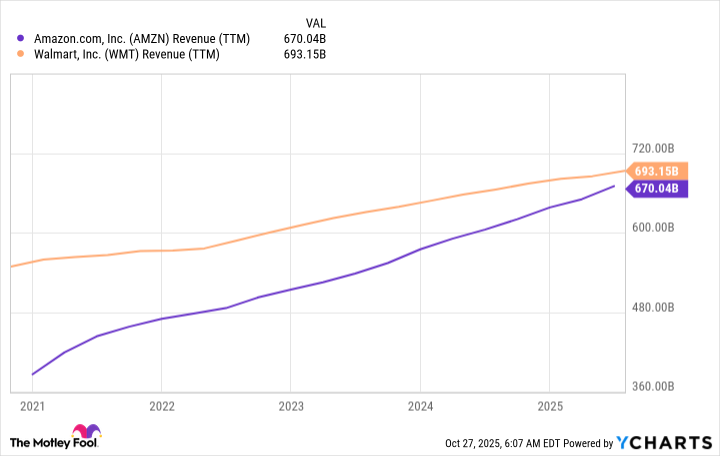Inflation is still climbing, unemployment has been on the rise, and it's starting to feel like an uncertain economy is just the new normal. One thing that has surprised analysts is that despite whatever's happening in the background, consumers keep spending.
Retailers haven't necessarily had it easy. They, too, are dealing with increased costs, changing trends, and attracting customers to their stores. But there are essentials that everyone has to buy, and customers are increasingly shopping at the large stores that can give them the greatest value.
Amazon (AMZN +1.63%) has drawn a lot of attention for its recent advances in artificial intelligence (AI), but retail, specifically in e-commerce, is still its core business. It's enjoying robust growth in e-commerce, as well as staggering growth in AI, and together, these twin growth engines are propelling it toward becoming the company with the highest sales in the world. It's not quite there yet, but I predict it will happen next year.

Image source: Amazon.
Still in second place
Amazon has spent several years in second place behind perennial leader and longtime competitor Walmart, but it continues to close the gap. Walmart is just that much bigger, but Amazon is on the cusp of overtaking it.
AMZN Revenue (TTM) data by YCharts
Amazon is still reporting double-digit sales growth. These days, retail is strong, and it has the added benefit of the AI business. AI is already bringing in billions in sales, and as of the end of the second quarter, it had a $123 billion run rate. That's likely to increase as Amazon harnesses the opportunity.
CEO Andy Jassy has mentioned several times that 85% to 90% of global information technology spend is still on the premises, but that it's going to switch to the cloud over the next decade or two. Having the ability to engage with AI through Amazon Web Services (AWS) or any cloud provider is speeding that up.
Walmart has been impressing investors with its strong performance, but its increases are in the single digits, which is how Amazon keeps getting closer. In the past two quarters, for example, Walmart has reported higher sales than Amazon, but they were up 4% and 5.6% year over year (currency neutral) vs. 10% and 12% for Amazon.
With Amazon behind by $23 billion, it's likely to overtake Walmart sometime next year.

NASDAQ: AMZN
Key Data Points
Twin growth engines
Amazon has been hard at work improving its value proposition in e-commerce. That means adding more products and reaching more people with faster delivery. If buyers know that their Amazon orders will get to them faster than if they have to run out to their local Walmart or other retailer, and they can get more of the products they need, they'll be more likely to order and have products show up at their door. The company is also benefiting from organic growth as e-commerce continues to increase as a percentage of retail sales.
AWS sales continue to outpace e-commerce, though, up 17% over last year in the second quarter, and that could accelerate with AI. Jassy said it's still early innings, and "It's a very unusual opportunity that we're very bullish about." According to Grand View Research, the AI market opportunity is expected to reach $3.5 trillion by 2033, while according to UNCTAD (United Nations Conference on Trade and Development), it's going to reach $4.8 trillion.
Jumpstarting the stock
Amazon is trailing the market this year, up only a mediocre 2% as of this writing. But the long-term opportunity is in its favor, and becoming the largest company in the world by sales gives it a dominant position that's hard to ignore.
2026 could be a big rebound year for Amazon, and now is a great time to buy the stock.






